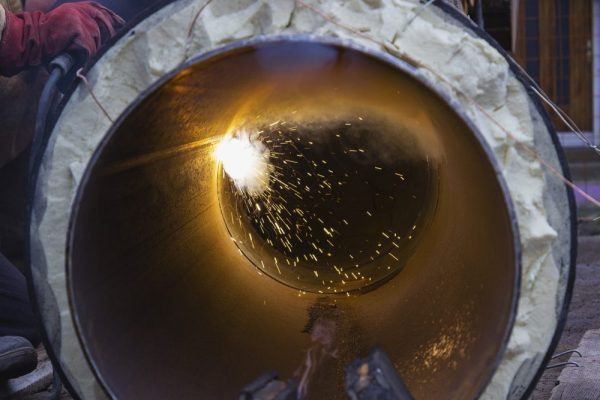Induction heating is lowering the risk of cracking welds in a number of industries where the welding of steel and metal alloys is a common and crucial to completing projects. Infrastructure, like pipelines, require welds. However, these projects aren’t simple and easy. Operators constantly battle to complete successful welds, as cracking leads to costly repairs and downtimes.

High-strength steel is particularly in demand because it can have thinner walls while maintaining necessary strength, but with this material comes common welding issues. Welds must withstand thermal expansion and contraction–common environmental factors–as well as additional weather considerations. Cold climates are the biggest pain area for operators as they create temperature uniformity issues, which leads to quality control and safety problems.
The Risk of Hydrogen-Induced Cracking
The main problem workers seek to avoid during welds is cracking. A common cause of cracking is when hydrogen ions gather in open spaces in the microstructure of the metal. When these molecules recombine to create hydrogen gas, they stress the structure of the material. Growing collections of the gas increase stress and lead to cracks.
Hydrogen-related cracking isn’t merely an issue during the actual weld operation. Cracks can form slowly–hours or days after the weld is complete–making it even more crucial the work is performed correctly the first time.
Temperature’s Everlasting Importance
Pre- and post-weld heating is the best way to diffuse hydrogen ions, reduce the risk of stress and therefore, lower the chance of cracking. Hydrogen ions specifically diffuse best at temperatures of 250 degrees Fahrenheit or higher. However, reaching a certain temperature isn’t enough. Professionals need to ensure the correct temperature is hit and lowered at the optimal pace.
Heating and cooling the base metal too quickly adds stress during welding. Rapid heating and cooling can create hard grain structures in the metal, which open up places for hydrogen ions to collect. Cooling the metal down too quickly, in particular, prevents the hydrogen ions from dispersing, which means they can gather and embrittle the metal. Ultimately, poor temperature pacing can lead to the accumulation of hydrogen ions as well as provide microfissures for these molecules to collect.
Heating Methods and Crack Prevention
Determining which heating method is most appropriate for the weld project and environment is the first step to preventing hydrogen accumulation and cracking. Open flame heating is a common method in pipeline construction, but certain disadvantages may make it the wrong choice.
In cold weather, a common challenge, open flame heating is often inefficient as the heat can’t be uniformly distributed. Instead of heating the metal, workers end up warming the surrounding air and environment.
The fuel for open heating can contribute to the accumulation of hydrogen ions, the very issue operators want to avoid. In cold projects, the water vapor generally condenses near the weld site, later melting and adding hydrogen to the environment.
Additionally, open heating creates worker safety issues. Operators must be careful not to have flammable clothing, equipment or other materials near the flame.
Warming up to Induction Heating
Induction heating has gained popularity due to its ease of use, consistency and safety. This method allows for a quicker and more uniform heating of the weld and for better hydrogen diffusion compared to open flame heating.
Induction uses electromagnetic heating to warm up the metal. The method creates localized eddy currents under the coils, and the metal’s resistance to these eddy currents causes it to heat up, without making the coils hot as well. There is no open flame to potentially harm workers and no water vapor to increase the amount of hydrogen in the environment.
This method allows the metal to be continuously heated during the weld, which is incredibly important in cold temperatures where workers are fighting to keep themselves and equipment warm.
Previously, induction heating was used during indoor shop environments and was too expensive for outdoor applications. However, technological advancements have lead to smaller and more efficient inverter technology, as well as more flexible coils that can be used on multiple applications.
Due to many producers working in harsh temperatures, it’s unlikely the risk of cracking will ever be entirely eliminated. However, induction heating has come a long way and is improving welding operations around the world.
Read more:
Use of Natural Gas Growing
More Natural Gas Needed Globally
Natural Gas Vehicles: Transportation Industry Fuels Demand for CNG Infrastructure
How to Create a Safer Oil and Gas Work Site
How Oil and Gas Companies Use Big Data to Improve Cybersecurity
Oil and Gas Companies Are Turning Their Assets Into Smart Fields
E-commerce offerings:
Natural Gas, Pipe, Valve and Fitting
Leak Detection
Pipeline Pigs
Pipe
Tools and Equipment
Contact a Customer Service Representative for selections, options, and solutions (866-483-7289).
Did you know that any customer is eligible for online ordering? All you need to do is fill out this online form.
Key benefits include:
- Order anytime, 24/7, 365 days a year. If you can connect, you can place an order.
- Create custom order templates, aka “My Lists” Reduce search time, click, order, done.
- Track purchase history and view your account information. You can review invoices any time, track purchase history, and print or download records.